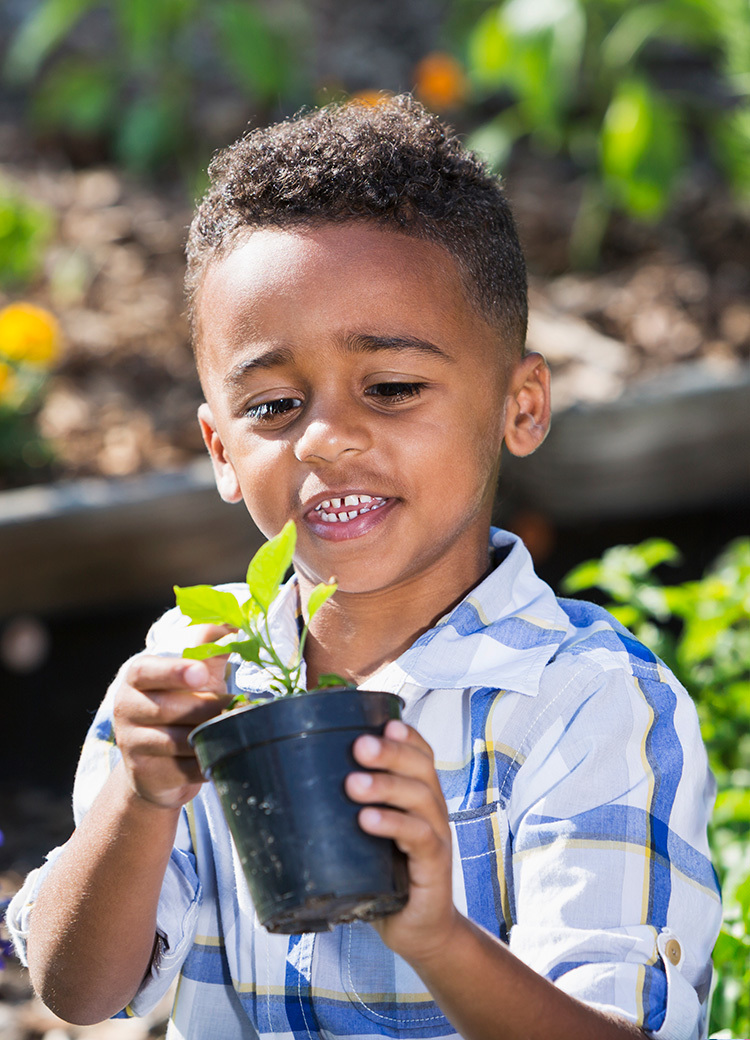Observations from a Monarch waystation
The library's Monarch waystation and pollinator habitat is attracting exciting visitors. On Earth Day, numerous Monarch caterpillars were spotted feeding on Common milkweeds. Migrating Monarchs from the south arrived in northeast Kansas early this spring and we noted one lingering female had especially faded wings indicating she was of the overwintering population arriving from Mexico. Swamp milkweeds had not yet sprouted, but the Common milkweeds originally planted in 2014 were healthy and available upon the Monarchs' early arrival with sufficient growth to accommodate the egg-laying females and caterpillars.
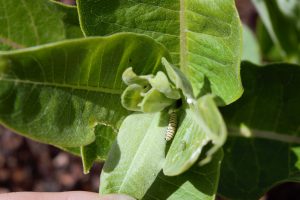
Monarch Caterpillar on Common Milkweed
Painted Lady butterflies were reported in the waystation the first week of August nectaring voraciously on the purple and pink blossoms of Western Ironweed and Joe-pye weed. The Painted Lady's distribution includes all continents except Australia and Antarctica. They offer quality close-up photo opportunities when gathering and feeding in great numbers. August is a good time to grab the camera and visit local gardens on a sunny morning to capture their visually exquisite markings before they move on.
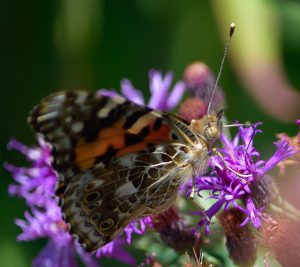
Painted Lady on Ironweed
Other butterfly species in the waystation include Black Swallowtail, Eastern Tiger Swallowtail, Common Buckeye, Eastern Tailed-Blue, Gray Hairstreak, Variegated Fritillary and Orange Sulphur along with various skippers that can be tricky to identify. Milkweed bugs, aphids, lady beetles and a variety of bee and wasp species are common.
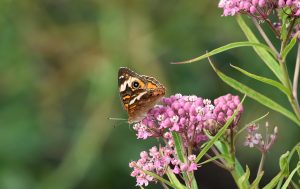
Common Buckeye on Swamp Milkweed
Generally a Monarch waystation habitat attracts nectivores, predators and parasites, especially if host plants used by multiple butterfly species are included. Tachinid flies, an example of a parasitoid, lay their eggs on several insect species including caterpillars. Look closely and you may notice stationary caterpillars that have been parasitized by this fly or some other parasitoid.
While watching the Painted Ladies in the waystation last week, I photographed an unfamiliar wasp-like insect nectaring on Swamp milkweed blossoms and an immobile grasshopper resting atop the blossoms of another close Swamp milkweed. Research confirmed the insect is a Great Golden Digger Wasp, a solitary pollinator known to paralyze grasshoppers and transport them to their burrows. Is this the predator responsible for the grasshopper's condition? Maybe it's a reproducing female with a burrow nearby?
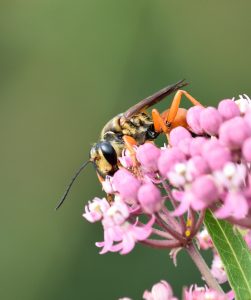
Great Golden Digger Wasp on Swamp Milkweed
Fall migration is evident in mid to late August and we are seeing that in the waystation now. Increased Monarch activity includes sightings of 4th and 5th instar caterpillars on milkweeds, with both males and females spending prolonged periods at the waystation. One female was observed depositing eggs on Common milkweeds on August 22, revealing her preference for this milkweed species versus the Swamp milkweeds blossoming in the waystation now. Check out Journey North's explanation of Monarchs preparing to make the long trip south to overwinter in Mexico. They report sightings in the northern part of the Monarch's range indicate a successful 2017 breeding season!
Incorporating native trees, milkweeds, other Kansas native flowering plants and butterfly host plants that bloom at various times throughout the growing season into your yard will provide valuable food and shelter for migrating and reproducing butterflies. Other beneficial insects and pollinators will find and share these food resources. This unique habitat begs for close and continual observation. There's a lot going on out there! Initial research and first-hand observations will result in a productive gardening-for-wildlife experience. Keep a garden journal and share your sightings and photos to inspire others to get involved in helping our pollinators. Consider participating in citizen science projects such as the Lost Ladybug Project, Journey North, Painted Lady Research and Bumble Bee Watch.
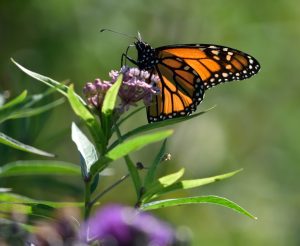
Monarch on Swamp Milkweed
Visit Monarch Watch's fall open house in Lawrence on Sept 9 at 9am to tour their waystation and learn about their renowned research.
(Photos here by Kim Sain taken in the TSCPL Monarch waystation in April (caterpillar) and August 2017. Featured photo of multiple Monarchs on Swamp milkweed taken in the waystation by Travis Garwood, September 2016.)










